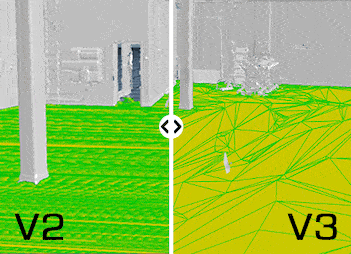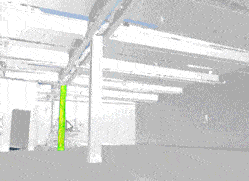Even though V2 of Pointfuse is barely a year old, Arithmetica is already gearing up for V3. The new release of this software—which automatically converts point clouds into vector models for use in design and engineering software—offers what Arithmetica calls a “new approach to the processing of point cloud data.” The company says V3 is faster at processing, but also reduces the file-size of 3D models by as much as 75%, and includes tools that allow you to edit your files in new ways—and reduce file size even further.
To find out more, I caught up with Arithmetica’s North American Channel Manager, Will Tompkinson (who you may know as a blogger for SPAR3D).
Fewer triangles, smaller files
A possible explanation for the quick development of V3: Tompkinson says that the upgrade from Pointfuse V1 to V2 brought a number of benefits, but one big challenge.

V3 eliminates redundancies in surface features while retaining the same level of detail.
Since V2 featured a set of processing algorithms that had been rebuilt from the ground up, the software produced models of much higher quality, and with much higher detail. “The thing was,” Tompkinson says, “with increasingly detailed models, you’re going to have to have more data. When we talk about meshing algorithms, that means more triangles, which means larger file sizes.”
Fortunately, the new processing algorithms that Arithmetica had developed for V2 could be tweaked to retain that high model detail while reducing file size significantly. “We were able to adjust multiple parameters in our model that are difficult to adjust if you are deploying a traditional meshing algorithm,” Tompkinson says. “With the statistics that Pointfuse has employed, we can reduce the number of triangles while still maintaining the outline of the feature.”
Pointfuse V3 promises 3D models with the same fidelity and detail as those produced by V2, just 50% smaller.
Multi-select tools, even smaller files
V3 introduces multi-selection tools for exploiting the selectable mesh files that Pointfuse generates.

The multi-select tool in action.
In the new version, you can click (or use a lassoing tool) to select multiple surfaces and group them into a layer—as if you’re editing a photo in Photoshop. Using this tool, Tompkinson says, you can select any number of surfaces and output them as a separate file. That could mean generating a file with geometry for just the floor, or the walls and the floor, or any combination of surfaces you want according to your own classification scheme or grouping preferences. Then you export the file for use in your design software.
For providers working with customers don’t need the whole point cloud—in MEP, for instance—this multi-select tool offers simplified 3D models and reduces file sizes by a non-trivial amount. Tompkinson says that some clients have used this workflow to convert files that were 100 MB in size, ending up with “a file that’s very emailable.”
With these smaller file sizes and new tools, Pointfuse can reliably produce mesh files that are 25% the size of the original point cloud. However, in most instances, Arithmetica says the reduction in file size will be even bigger.
No-worry point clouds
Tompkinson hopes that Pointfuse V3 will make an even better tool for users who “require a swift way to share data and start working on the information they’ve captured, rather than having to worry about transporting point clouds around, or converting point clouds, or having to work out what’s in a point cloud to begin with. These are all tasks that hold up the use of reality capture technology, so we see Pointfuse as a driver to change that.”
Pointfuse V3 is set for release on September 18th, 2017. For more information, see Arithmetica’s website.









